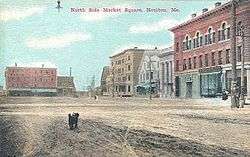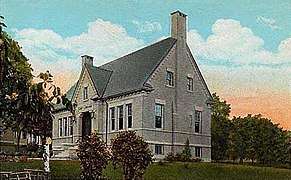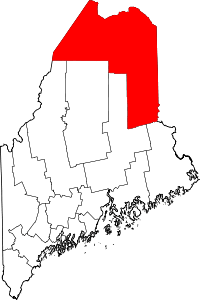Houlton, Maine
Houlton is a town in Aroostook County, Maine, on the Canada–US border, located at 46.1256°N 67.8398°W. As of the 2010 census, the town's population was 6,123. It is perhaps best known for being at the northern terminus of Interstate 95 and as the birthplace of Samantha Smith, a goodwill ambassador as a child during the Cold War. The town hosts the annual Houlton Agricultural Fair.
Houlton, Maine | |
|---|---|
 Seal | |
| Nickname(s): Capital of Aroostook | |
| Motto(s): Valuing the past, planning for the future | |
 Houlton Location in the state of Maine  Houlton Houlton (the United States) | |
| Coordinates: 46°7′32″N 67°50′23″W | |
| Country | United States |
| State | Maine |
| County | Aroostook |
| Settled | 1807 |
| Incorporated | March 8, 1831 |
| Villages | Houlton Carys Mills |
| Area | |
| • Total | 36.73 sq mi (95.13 km2) |
| • Land | 36.71 sq mi (95.08 km2) |
| • Water | 0.02 sq mi (0.05 km2) |
| Elevation | 390 ft (119 m) |
| Population | |
| • Total | 6,123 |
| • Estimate (2012[3]) | 6,065 |
| • Density | 166.8/sq mi (64.4/km2) |
| Time zone | UTC-5 (Eastern (EST)) |
| • Summer (DST) | UTC-4 (EDT) |
| ZIP codes | 04730, 04761 |
| Area code(s) | 207 Exchange: 532 |
| FIPS code | 23-33980 |
| GNIS feature ID | 0582525 |
| Website | houlton-maine.com |
Houlton is the county seat of Aroostook County, and as such its nickname is the "Shire Town". The Houlton High School sports teams are named "The Shiretowners". The Meduxnekeag River flows through the heart of the town, and the border with the Canadian province of New Brunswick is 3 mi (4.8 km) east of the town's center. Houlton was the home of Ricker College, which closed in 1978.[4]
The primary settlement and center of the town is designated as a CDP with the same name. The headquarters of the federally recognized Houlton Band of Maliseet Indians is based here.[5]
History

The area was occupied for thousands of years by varying cultures of indigenous peoples. In historic times, these were the Algonquian-speaking Maliseet people. When Maine was part of Massachusetts, parcels of land were dealt out to schools and colleges. The area that was to become Houlton was deeded to the Academy of New Salem, Massachusetts. Thirteen men from New Salem bought the land from the Academey though only three settled there.[6]
Decades after the American Revolutionary War, Anglo-American pioneers Aaron Putnam and Joseph Houlton started a village. They named it for Houlton, who had moved to Maine in 1807 from the more populated part of Massachusetts.[7] Maine separated from Massachusetts in 1820 and became an independent state.
In 1828 the United States government established Hancock Barracks, a military post, in the area. Houlton officially incorporated as a town in 1831. When the Aroostook War flared in 1839 over the border with Canada, three companies of the 1st Artillery Regiment manned Hancock Barracks under Major R. M. Kirby. Major Kirby helped to restrain the twelve companies of militia that Maine sent there from starting a shooting war. The Webster-Ashburton Treaty settled the boundary dispute in 1842, and the Army abandoned Hancock Barracks in 1847.[8]
The U.S. Army installed its first transatlantic[9] Radio Intelligence Station 1.5 miles east of the town center of Houlton, Maine,[10] during World War I. The Houlton Radio Intelligence Station intercepted German diplomatic communications, primarily from its Nauen Transmitter Station. MI-8 created the Radio Intelligence Service, using selected Signal Corps personnel for the sole purpose of supporting strategic intelligence through radio intercepts during World War I. The United States intelligence services built Houlton as the first unit of its type, and its success helped to lay the foundation for many more United States long-range radio-intercept stations.
On 7 January 1927, AT&T initiated the first transatlantic commercial telephone service,[11] linking New York and London. The AT&T Transoceanic Receiver Station was located at the end of Hand Lane, 46.1270°N 67.8841°W, two miles west of the town center. The massive receiving antenna,[12] over three miles long and two miles wide, straddled what is now Interstate 95 in Maine four miles west of the center of Houlton. The receiver station worked with the large long-wave transmitting facility of AT&T located at RCA [13] in Rocky Point, New York. The receiver station received the longwave telephone signal from the British General Post Office Rugby transmitting station near Rugby, England.[14] The Rugby Radio Station ceased operations in 2007. On its site is a new large scale housing development, also called Houlton.
The US Army established Houlton Army Air Base in 1941 immediately adjacent to the Canada–US border.[15] Prior to the United States' entry into World War II, American army pilots flew planes to the base. They could not fly the planes directly into Canada, a member of the British Commonwealth, because that would violate the official United States position of neutrality. Local farmers used their tractors to tow the planes into Canada, where the Canadians closed the Woodstock highway so that aircraft could use it as a runway.
A Royal New Zealand Air Force pilot, officer George Newall Harrison,[16] died on 5 December 1942 when he crashed 500 yards south of the runway while ferrying a Hudson Bomber to Britain.[17] Survivors buried his body in the Evergreen Cemetery plot for veterans. Few other New Zealand casualties from World War II were buried in the United States of America. His 19-year-old radio operator, Sergeant Henry Bordewick,[18] also died and was buried there; he was from Vancouver, British Columbia, Canada. The American Legion post in Houlton maintains both these Commonwealth War Graves.
Houlton Army Air Base closed in July 1944. In 1944, the Army adapted a major part of the Houlton Army Air Base for use as prisoner of war internment in Camp Houlton. At its peak, the internment camp held 3,700 German prisoners of war. Forcing prisoners of war to work violated the Geneva Convention; however, they could volunteer to work. Camp Houlton provided laborers for local farms to harvest peas, pick potatoes, and do other labor. For security reasons, the government did not allow every prisoner of war to work on the farms. Most prisoners selected to work did not want to harm their captors or cause trouble. Many farmers came to consider the prisoners of war who worked their fields as good laborers rather than enemy soldiers. They paid the prisoners $1/day in scrip, which the prisoners could spend at the post exchange, the base store, to buy toiletries, tobacco, chocolate, or beer. After the prisoners repatriated, the Army closed Camp Houlton in 1946. The site was redeveloped as Houlton International Airport.

Geography and climate
According to the United States Census Bureau, the town has a total area of 36.73 square miles (95.13 km2), of which 36.71 square miles (95.08 km2) is land and 0.02 square miles (0.05 km2) is water.[1] Houlton is drained by the Meduxnekeag River.
Interstate 95 has its northernmost two exits in Houlton. The Houlton/Woodstock Border Crossing, located to the east of downtown Houlton, marks the northern terminus of Interstate 95. The town is also crossed by U.S. Route 1 and U.S. Route 2, which have a brief concurrency in the center of town.
Typically for Maine, Houlton has a humid continental climate (Köppen Dfb) with cold and snowy winters typically featuring forty-six nights – comparable to Fargo – below 0 °F or −17.8 °C and eighty-three days failing to reach freezing, plus warm summers. The coldest month between 1971 and 2000 was January 1994 with a mean temperature of 0.7 °F or −17.4 °C, though data from nearby stations suggest the Januaries of 1920 and 1925 were equally cold.[19] Snow depth typically reaches 14 inches or 0.36 metres in February, and has been as high as 71 inches or 1.80 metres at the close of January, 1998.
| Climate data for Houlton, Maine (1981–2010 normals) | |||||||||||||
|---|---|---|---|---|---|---|---|---|---|---|---|---|---|
| Month | Jan | Feb | Mar | Apr | May | Jun | Jul | Aug | Sep | Oct | Nov | Dec | Year |
| Record high °F (°C) | 58 (14) |
62 (17) |
79 (26) |
86 (30) |
96 (36) |
97 (36) |
97 (36) |
99 (37) |
93 (34) |
82 (28) |
71 (22) |
59 (15) |
99 (37) |
| Average high °F (°C) | 22.3 (−5.4) |
26.5 (−3.1) |
36.1 (2.3) |
49.9 (9.9) |
63.8 (17.7) |
72.5 (22.5) |
77.6 (25.3) |
75.9 (24.4) |
66.9 (19.4) |
53.9 (12.2) |
40.8 (4.9) |
28.6 (−1.9) |
51.2 (10.7) |
| Average low °F (°C) | 0.9 (−17.3) |
3.6 (−15.8) |
15.0 (−9.4) |
28.3 (−2.1) |
38.5 (3.6) |
47.8 (8.8) |
53.8 (12.1) |
51.6 (10.9) |
43.2 (6.2) |
33.0 (0.6) |
24.4 (−4.2) |
10.3 (−12.1) |
29.2 (−1.6) |
| Record low °F (°C) | −41 (−41) |
−36 (−38) |
−31 (−35) |
−6 (−21) |
18 (−8) |
28 (−2) |
32 (0) |
30 (−1) |
20 (−7) |
10 (−12) |
−14 (−26) |
−34 (−37) |
−41 (−41) |
| Average precipitation inches (mm) | 2.74 (70) |
2.10 (53) |
2.66 (68) |
2.79 (71) |
3.40 (86) |
3.71 (94) |
3.71 (94) |
3.78 (96) |
3.35 (85) |
3.84 (98) |
4.06 (103) |
3.35 (85) |
39.48 (1,003) |
| Average snowfall inches (cm) | 21.3 (54) |
16.0 (41) |
17.2 (44) |
5.5 (14) |
.1 (0.25) |
0 (0) |
0 (0) |
0 (0) |
.1 (0.25) |
.8 (2.0) |
7.3 (19) |
15.6 (40) |
83.8 (213) |
| Average precipitation days (≥ 0.01 in) | 11.9 | 9.9 | 11.6 | 11.9 | 13.0 | 12.8 | 13.0 | 11.5 | 10.3 | 12.7 | 12.3 | 12.8 | 143.6 |
| Average snowy days (≥ 0.1 in) | 9.3 | 7.8 | 6.9 | 2.7 | 0 | 0 | 0 | 0 | .1 | .5 | 2.8 | 7.9 | 38.0 |
| Source: NOAA (extremes 1948–present)[20] | |||||||||||||
Demographics
| Historical population | |||
|---|---|---|---|
| Census | Pop. | %± | |
| 1820 | 115 | — | |
| 1830 | 579 | 403.5% | |
| 1840 | 1,597 | 175.8% | |
| 1850 | 1,453 | −9.0% | |
| 1860 | 2,035 | 40.1% | |
| 1870 | 2,850 | 40.0% | |
| 1880 | 3,228 | 13.3% | |
| 1890 | 4,015 | 24.4% | |
| 1900 | 4,686 | 16.7% | |
| 1910 | 5,845 | 24.7% | |
| 1920 | 6,191 | 5.9% | |
| 1930 | 6,865 | 10.9% | |
| 1940 | 7,771 | 13.2% | |
| 1950 | 8,377 | 7.8% | |
| 1960 | 8,289 | −1.1% | |
| 1970 | 8,111 | −2.1% | |
| 1980 | 6,766 | −16.6% | |
| 1990 | 6,613 | −2.3% | |
| 2000 | 6,476 | −2.1% | |
| 2010 | 6,123 | −5.5% | |
| Est. 2014 | 5,946 | [21] | −2.9% |
| U.S. Decennial Census[22] | |||
2010 census
As of the census[2] of 2010, there were 6,123 people, 2,556 households, and 1,563 families residing in the town. The population density was 166.8 inhabitants per square mile (64.4/km2). There were 2,822 housing units at an average density of 76.9 per square mile (29.7/km2). The racial makeup of the town was 91.0% White, 0.7% African American, 5.8% Native American, 0.5% Asian, 0.4% from other races, and 1.7% from two or more races. Hispanic or Latino of any race were 1.1% of the population.
There were 2,556 households of which 30.2% had children under the age of 18 living with them, 43.2% were married couples living together, 13.5% had a female householder with no husband present, 4.5% had a male householder with no wife present, and 38.8% were non-families. 33.9% of all households were made up of individuals and 17.1% had someone living alone who was 65 years of age or older. The average household size was 2.27 and the average family size was 2.87.
The median age in the town was 43.2 years. 22.4% of residents were under the age of 18; 7.2% were between the ages of 18 and 24; 22.9% were from 25 to 44; 27.6% were from 45 to 64; and 19.8% were 65 years of age or older. The gender makeup of the town was 46.4% male and 53.6% female.
2000 census
As of the census of 2000, there were 6,476 people, 2,677 households, and 1,654 families residing in the town. The population density was 176.2 people per square mile (68.0/km²). There were 2,994 housing units at an average density of 31.5 persons/km² (81.5 persons/sq mi). The racial makeup of the town was 94.19% White, 0.29% African American, 4.23% Native American, 0.48% Asian, 0.08% Pacific Islander, 0.09% from other races, and 0.63% from two or more races. 0.43% of the population were Hispanic or Latino of any race.
There were 1,677 households out of which 29.5% had children under the age of 18 living with them, 47.4% were married couples living together, 11.0% have a woman whose husband does not live with her, and 38.2% were non-families. 34.3% of all households were made up of individuals and 18.0% had someone living alone who was 65 years of age or older. The average household size was 2.29 and the average family size was 2.94.
In the town, the population was spread out with 23.7% under the age of 18, 7.1% from 18 to 24, 26.0% from 25 to 44, 21.9% from 45 to 64, and 21.3% who were 65 years of age or older. The median age was 40 years. For every 100 females, there were 87.5 males. For every 100 females age 18 and over, there were 82.4 males.
The median income for a household in the town was $26,212, and the median income for a family was $34,812. Males had a median income of $27,623 versus $20,991 for females. The per capita income for the town was $14,007. 17.7% of the population and 13.5% of families were below the poverty line. Out of the total people living in poverty, 21.0% are under the age of 18 and 15.8% are 65 or older.
Sites of interest
- Amazeen House, built in 1882 and listed on the National Register of Historic Places
- Aroostook County Courthouse and Jail
- Aroostook County Historical & Art Museum
- Blackhawk Putnam Tavern
- Cary Library
- Edward L. Cleveland House
- Unitarian Church of Houlton
- Walter P. Mansur House
Notable people
- Ralph Botting, pitcher for the California Angels
- Michael E. Carpenter, Maine Attorney General and state legislator
- Shepard Cary, US congressman
- Marcus Davis, mixed martial arts fighter with the Ultimate Fighting Championship
- William Dufris, original voice of Bob the Builder in North America
- Ira G. Hersey, US congressman
- Stan Hindman, defensive lineman for the San Francisco 49ers
- Debra Lee Hovey, Connecticut State Representative
- Jean E. Howard, George Delacorte Professor of the Humanities at Columbia University
- Colonel Frank M. Hume, commanding officer of the 103rd Infantry, 26th Division during World War I
- Happy Iott, Major League Baseball outfielder
- Natalie Kalmus, influence Technicolor engineer
- Alton Kelley, psychedelic poster artist
- Lester D. Mallory, diplomat
- Henry Clay Merriam (1837–1912), Civil War-era general, awarded the Medal of Honor
- Bern Porter (1911-2004), artist, writer, and scientist
- Samantha Smith (1972-1985), child peace activist
- Danny Wilde (musician), guitarist, singer, and founding member of pop group The Rembrandts.
- Eliza Tupper Wilkes (1844-1917), Unitarian Universalist minister, suffragist
References
- "US Gazetteer files 2010". United States Census Bureau. Archived from the original on 2012-12-20. Retrieved 2012-12-16.
- "U.S. Census website". United States Census Bureau. Retrieved 2012-12-16.
- "Population Estimates". United States Census Bureau. Archived from the original on 2013-06-11. Retrieved 2013-07-06.
- "Ricker - Ricker College - Ricker Classical Institute". Archived from the original on 1999-02-08.
- "Houlton Band of Maliseet Indians." Archived 2013-12-02 at the Wayback Machine Region 1: EPA New England. Retrieved 30 July 2013.
- Hamlin, Helen (1948). Pine, potatoes and people : the story of Aroostook. W.W. Norton.
- "George J. Varney, ''History of Houlton, Maine,'' Boston 1886". History.rays-place.com. Retrieved 2017-08-13.
- Maine League of Historical Societies and Museums (1970). Doris A. Isaacson (ed.). Maine: A Guide 'Down East'. Rockland, Maine: Courier-Gazette, Inc. pp. 183–188.
- "houlton site:nsa.gov - Google Search". External link in
|title=(help) - "MI-8". Archived from the original on 27 September 2007. Retrieved 13 August 2017.
- Charles William Taussig (1922). The Book of Radio--Radio Central chapter. pp. 312–327.
- "Subterranea Britannica: Sites: Rugby Radio Station".
- "Maine Memory Network - Site of the Houlton Army Air Base". Maine Memory Network.
- Reading Room Manchester. "CWGC - Casualty Details".
- "Archived copy". Archived from the original on 2008-03-31. Retrieved 2008-08-01.CS1 maint: archived copy as title (link)
- Reading Room Manchester. "CWGC - Casualty Details".
- National Oceanic and Atmospheric Administration; Maine Climate division 1 January Average Temperature
- "NowData – NOAA Online Weather Data". National Oceanic and Atmospheric Administration. Retrieved 2013-06-03.
- "Annual Estimates of the Resident Population for Incorporated Places: April 1, 2010 to July 1, 2014". Archived from the original on May 23, 2015. Retrieved June 4, 2015.
- "Census of Population and Housing". Census.gov. Retrieved June 4, 2015.
External links
| Wikimedia Commons has media related to Houlton, Maine. |
| Wikivoyage has a travel guide for Houlton. |
